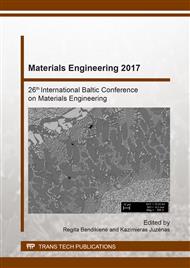[1]
Future Trends in the World Leather. Leather Products Industry and Trade, Vienna, UNIDO, (2010).
Google Scholar
[2]
Yu. Fordzyun, O. Andreyeva, L. Maistrenko, Level of comfort: artificial and natural shoe materials. A comprehensive assessment, Key Engineering Materials. 559 (2013) 25-30.
DOI: 10.4028/www.scientific.net/kem.559.25
Google Scholar
[3]
R. Daniels, The scientific and commercial significance of variations in strength and stretch in leather, World Leather. (2007) 20-25.
Google Scholar
[4]
M.M. Mutlu, N. Ork, O. Yegin, S. Bas, Mapping the variations of tensile strength over the area of sheepskin leather, Annals of The Universıty of Oradea. 15 (2014) 157-162.
Google Scholar
[5]
T. Covington, Tanning chemistry: The science of leather, RSC publishing, (2009).
Google Scholar
[6]
G.C. Jayakumar, L.S. Bala et al, Combination tanning system based on dialdehyde olginic acid: an ecofriendly organic approach, JALCA. 106 (2011) 50-58.
Google Scholar
[7]
M.O. Marukhlenko, V.A. Palamar, O.R. Mokrousova, Stabilizing derma collagen structure with modified dispersions of montmorillonite, IOP Conf. Series: Materials Science and Engineering. 111 (2016).
DOI: 10.1088/1757-899x/111/1/012023
Google Scholar
[8]
A. Danylkovych, V. Lischuk, O. Zhyhotsky, Structuring of collagen of the dermis during rawhide formation, Chemistry&, Chemical Technology. 11 (2017) 81-91.
DOI: 10.23939/chcht11.01.081
Google Scholar
[9]
A. Nikonova, O. Andreyeva, L. Maistrenko, Application of advanced polymeric compounds for development of leather production, IOP Conf. Series: Materials and engineering. 111 (2016).
DOI: 10.1088/1757-899x/111/1/012024
Google Scholar
[10]
A.V. Nikonova, A.O. Andreyeva, L.A. Maistrenko, Determination of the optimal parameters of titanium tanning process using polymeric compound based on a maleic acid, Bulletin of KhNU. 233 (2016) 196-201. (in Ukrainian).
Google Scholar
[11]
L.A. Maistrenko, O.A. Andreyeva, The influence of liquor finishing by using polymers on the quality of dyeing and the most important properties in: G. Paraska, J. Kowal (Eds. ), Engineering and methodology of modern technology, KhNU, Khmelnytsky (2012).
Google Scholar
[12]
Leather. Physical and mechanical tests. Sample preparation and conditioning, IULTCS, ISO 2419, (2012).
Google Scholar
[13]
Leather. Physical and mechanical tests. Moisture content, IULTCS, ISO 4684, (2005).
Google Scholar
[14]
Leather. Chemical tests. Determination of matter soluble in dichloromethane and free fatty acid content, IULTCS, ISO 4048, (2008).
DOI: 10.3403/30360609
Google Scholar
[15]
Leather. Physical and mechanical tests. Determination of shrinkage temperature, IULTCS, ISO 3380, (2015).
Google Scholar
[16]
Leather. Determination of distension and strength of surface (Ball burst method), IULTCS, ISO 3379, (2015).
Google Scholar
[17]
Leather. Physical and mechanical tests. Determination of tensile strength and percentage extension, IULTCS, ISO 3376, (2011).
DOI: 10.3403/30203585
Google Scholar
[18]
Leather. Physical and mechanical tests. Determination of apparent density and mass per unit area, IULTCS, ISO 2420, (2002).
DOI: 10.3403/30301229
Google Scholar
[19]
Leather. Physical and mechanical tests. Determination of thickness, IULTCS, ISO 2589, (2016).
Google Scholar
[20]
Leather. Measurement of area, IULTCS, ISO 11646, (2014).
Google Scholar
[21]
Leather. Physical and mechanical tests. Determination of tear load, Part 1: Single edge tear, IULTCS, ISO 3377-1, (2011).
DOI: 10.3403/30213193
Google Scholar
[22]
Leather. Physical and mechanical tests. Determination of water vapour permeability, IULTCS, ISO 14268, (2012).
Google Scholar
[23]
Leather. Chemical determination of chromic oxide content, Part 1: Quantification by titration IULTCS, ISO 5398-1, (2007).
DOI: 10.3403/30360612
Google Scholar
[24]
A.I. Metelkin, N.T. Rusakova, Titanium tanning: Legkayaindustriya, 1980. (in Russian).
Google Scholar
[25]
A.A. Gorbachev, A.S. Kerner, O.A. Andreyeva et al, Basis for the creation of modern production technologies: KNUTD, 2007. (in Ukrainian).
Google Scholar
[26]
N. Johnson, S. Lyon, Statistics and planning of the experiment in engineering and science: World, (1980). (in Russian).
Google Scholar


